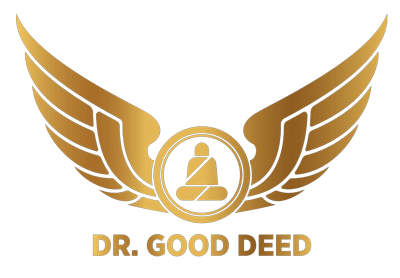Medically reviewed by Dr Chandril Chugh,
Renowned Neurologist and American Trained Specialist
Testicular cancer is a relatively rare form of cancer that primarily affects young men between the ages of 15 and 45. It starts in the testicles, which are responsible for producing sperm and the hormone testosterone. The first sign of testicular cancer is often a painless lump or swelling in one of the testicles. Other symptoms may include a feeling of heaviness in the scrotum, a dull ache in the lower belly or groin, sudden swelling in the scrotum, and pain or discomfort in the testicle or scrotum. Early detection is crucial for successful treatment, and regular self-checks and medical screenings are recommended.
Table of Contents
ToggleKey Takeaways:
- Testicular cancer primarily affects young men between 15 and 45.
- Early detection of testicular cancer is important for successful treatment.
- Common symptoms of testicular cancer include painless lumps or swellings in the testicles.
- Regular self-checks and medical screenings are recommended for early detection.
- Understanding the symptoms and risk factors of testicular cancer is crucial for men’s health.
Diagnosis and Treatment of Testicular Cancer
When it comes to testicular cancer, early diagnosis is crucial for effective treatment. To determine whether you have testicular cancer, your doctor will conduct a thorough physical examination of your testicles and scrotum. They will look for any lumps or swelling that could indicate the presence of cancerous cells.
In addition to the physical examination, your doctor may also recommend additional tests to confirm the diagnosis. These tests may include ultrasound imaging and blood tests to determine the tumor markers in your body. Ultrasound imaging can provide detailed images of your testicles, helping to identify any abnormalities or tumors. Blood tests, on the other hand, can measure the levels of certain proteins known as tumor markers, which are often elevated in individuals with testicular cancer.
Although these tests can provide valuable information, the only way to definitively diagnose testicular cancer is through the surgical removal of the affected testicle, a procedure known as orchiectomy. This allows the removed tissue to be examined under a microscope to confirm the presence of cancer cells.
Once the diagnosis is confirmed, staging tests such as chest x-rays and CT scans may be performed to determine the extent to which the cancer has spread to other parts of the body. This information helps to determine the appropriate treatment plan.
The treatment for testicular cancer depends on various factors, such as the stage and type of cancer. The three main treatment options for testicular cancer are:
- Surgery: Surgery is often the first line of treatment for testicular cancer. It involves removing the affected testicle through an orchiectomy. In some cases, a testis-sparing surgery may be possible, where only the tumor tissue is removed instead of the entire testicle.
- Radiation Therapy: Radiation therapy is used to kill cancer cells in the testicle or nearby lymph nodes. It is often recommended for individuals with seminoma type cancers.
- Chemotherapy: Chemotherapy involves the use of drugs to kill cancer cells. It is typically used for cancers that have spread beyond the testicles or if tumor markers rise after surgery.
These treatment options may be used individually or in combination, depending on the specific circumstances of your diagnosis. Your medical team will work with you to develop a personalized treatment plan that best suits your needs.
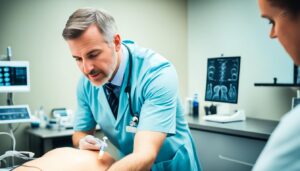
By detecting testicular cancer early and undergoing appropriate treatment, the chances of successful recovery are significantly higher. Regular self-checks and seeking medical attention for any concerning symptoms are essential for early detection. Remember, early diagnosis can save lives.
Treatment Options for Testicular Cancer
When it comes to treating testicular cancer, there are several options available. The specific treatment plan will depend on the stage and type of testicular cancer. Some of the common treatment options include:
- Surgery: Surgery is the primary treatment for testicular cancer. It involves removing the affected testicle through a procedure called orchiectomy. This surgical intervention is necessary to remove the cancerous tissue and prevent the spread of cancer to other parts of the body.
- Testis-sparing surgery: In certain cases, testis-sparing surgery may be considered. This procedure aims to remove only the tumor tissue while preserving the healthy testicular tissue. It is an option for individuals who wish to maintain fertility or have concerns about body image.
- Retroperitoneal lymph node dissection (RPLND): RPLND is a complex surgery that may be performed to remove lymph nodes in the back of the abdomen. It is typically done for certain types and stages of testicular cancer to prevent the spread of cancer cells to these lymph nodes.
- Radiation therapy: Radiation therapy uses high-energy rays to kill cancer cells. It is often employed to target cancer cells in the testis or nearby lymph nodes. However, radiation therapy is primarily effective for seminoma type cancers.
- Chemotherapy: Chemotherapy involves the use of powerful drugs to kill cancer cells. It is commonly recommended for testicular cancers that have spread beyond the testicles or if tumor markers rise after surgery. Chemotherapy may be administered intravenously or orally depending on the specific treatment regimen.
Each treatment option has its own benefits and considerations. The choice of treatment will be determined by the healthcare team based on the individual’s specific case. It’s important for patients to have open and honest discussions with their doctors to understand the potential risks, benefits, and expected outcomes of each treatment option.
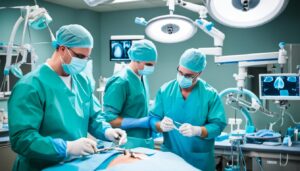
Remember, the goal of treatment is to effectively eradicate the cancer while preserving overall health and quality of life. The medical team will closely monitor the progress during and after treatment to ensure the best possible outcomes. Seeking timely medical attention and discussing treatment options with healthcare professionals can play a significant role in combating testicular cancer.
Surveillance as a Treatment Option
Surveillance is a valuable treatment option for certain stages of testicular cancer. It involves regular check-ups and monitoring to detect any changes or signs of progression. Surveillance is typically recommended for patients with stage 0 and some stage I cancers, such as stage I seminoma and stage I non-seminoma germ cell tumors.
During surveillance, you will undergo various tests and examinations to ensure that the cancer is being closely monitored. These may include:
- Physical exams: Your doctor will conduct regular physical examinations to check for any abnormalities and evaluate the condition of your testicles and scrotum.
- Tumor marker tests: Blood tests may be performed to measure the levels of specific tumor markers, which can indicate the presence or progression of testicular cancer.
- Imaging tests: Imaging techniques, such as ultrasound or CT scans, may be used to obtain detailed images of the testicles and surrounding areas, helping to identify any changes or growths.
The surveillance schedule may differ depending on the specific type and stage of testicular cancer. For stage I seminoma, surveillance may involve check-ups every six months for the first two years, followed by visits every six to 12 months in subsequent years. On the other hand, stage I non-seminoma germ cell tumors may require more frequent surveillance, with the frequency varying based on additional risk factors.
The purpose of surveillance is to promptly identify any signs of tumor growth or changes in hormone levels that may indicate the need for further treatment. By closely monitoring your condition, your healthcare team can intervene when necessary, ensuring timely intervention and improving your chances of successful treatment outcomes.
When considering surveillance as a treatment option, it’s important to maintain open communication with your healthcare team. They can guide you through the surveillance process, address any concerns or questions you may have, and help you make informed decisions about your treatment journey.
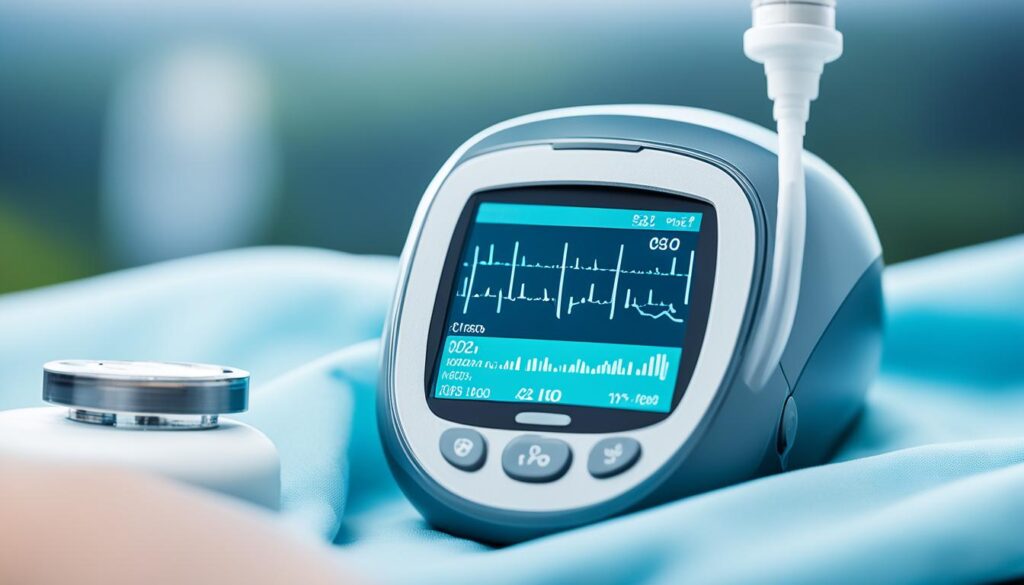
Benefits of Surveillance as a Treatment Option
“Surveillance offers a proactive approach to managing testicular cancer, allowing for close monitoring without immediate intervention. It provides valuable insight into the behavior and progression of the cancer, ensuring that treatment is initiated when necessary.”
Some benefits of surveillance as a treatment option include:
| Advantages of Surveillance | Explanation |
|---|---|
| Minimally invasive | Surveillance does not involve surgery or other invasive procedures, which can be beneficial for patients who prefer a non-invasive approach or wish to avoid potential side effects. |
| Preservation of fertility | Choosing surveillance over immediate treatment options, such as surgery, can help preserve fertility by avoiding the removal of the affected testicle. |
| Reduced treatment-related side effects | Delaying or avoiding treatment can minimize the occurrence of potential side effects associated with surgery, radiation therapy, or chemotherapy. |
| Customized treatment plan | Surveillance allows for personalized treatment based on individual risk factors, tumor characteristics, and patient preferences. |
It’s important to remember that surveillance may not be suitable for all cases of testicular cancer. It is crucial to discuss your specific situation and treatment options with your healthcare team to determine the most appropriate course of action.
Risk Factors and Prevention of Testicular Cancer
Testicular cancer risk factors can increase the chances of developing this disease. It’s essential to understand these factors and their impact on your health. The following are some significant risk factors associated with testicular cancer:
- Undescended Testicle: Having an undescended testicle, a condition where one or both testicles do not move into the scrotum, increases the risk of testicular cancer. If you or your child has experienced an undescended testicle, it is crucial to be aware of the potential risks. Regular self-examinations and medical screenings can aid in early detection.
- Family History: A family history of testicular cancer can contribute to an increased risk. If you have a close relative, such as a father or brother, who has had testicular cancer, make sure to consult with a healthcare professional and consider regular screenings.
- Age: Testicular cancer is most commonly diagnosed in young adult males between the ages of 15 and 35. Being aware of your age-related risk can prompt proactive measures, such as self-checks and routine medical examinations, to facilitate early detection.
- Race: White males are more susceptible to testicular cancer compared to other racial groups. Although the exact reasons for this disparity are not fully understood, it underscores the importance of vigilance and regular screenings for individuals of white race.
- Other Factors: Certain additional factors may contribute to an increased risk of testicular cancer. These include infertility, HIV and AIDS, certain physical features like Hypospadias, regular cannabis use, and specific intersex variations. While these factors may elevate the risk, they do not guarantee the development of testicular cancer.
It is important to note that while certain risk factors may increase the likelihood of testicular cancer, there are currently no known methods for preventing the disease entirely. However, early detection through self-checks and routine screenings remains crucial for identifying testicular cancer at its earliest stages, increasing the chances of successful treatment and positive outcomes.
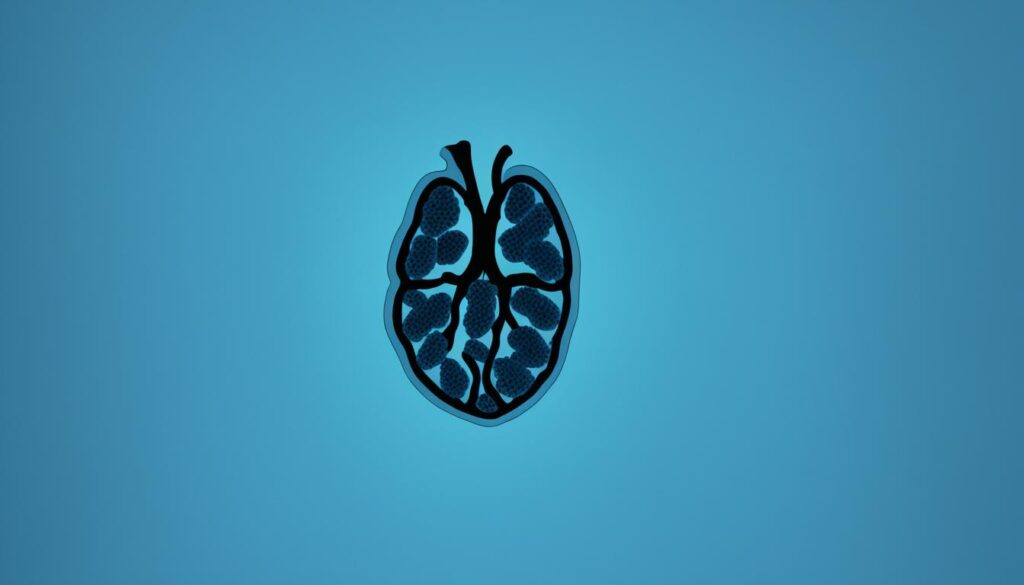
Symptoms and Signs of Testicular Cancer
Recognizing the symptoms and signs of testicular cancer is crucial for early detection and prompt medical intervention. While a painless lump or swelling in the testicle is the most common symptom, there are other indicators that should not be ignored. It’s important to pay attention to any changes in the testicles or groin area and seek medical attention if symptoms persist for more than two weeks.
Common Symptoms of Testicular Cancer:
- Painless lump or swelling in the testicle
- Feeling of heaviness in the scrotum
- Dull ache in the lower belly or groin
- Sudden swelling in the scrotum
- Pain or discomfort in the testicle or scrotum
- Enlargement or tenderness of the breast tissue
If you experience any of these symptoms, it is important not to ignore them. While they may not necessarily indicate testicular cancer, it is essential to consult with a medical professional to determine the cause and appropriate course of action. Keep in mind that early diagnosis and treatment significantly improve the chances of successful outcomes.
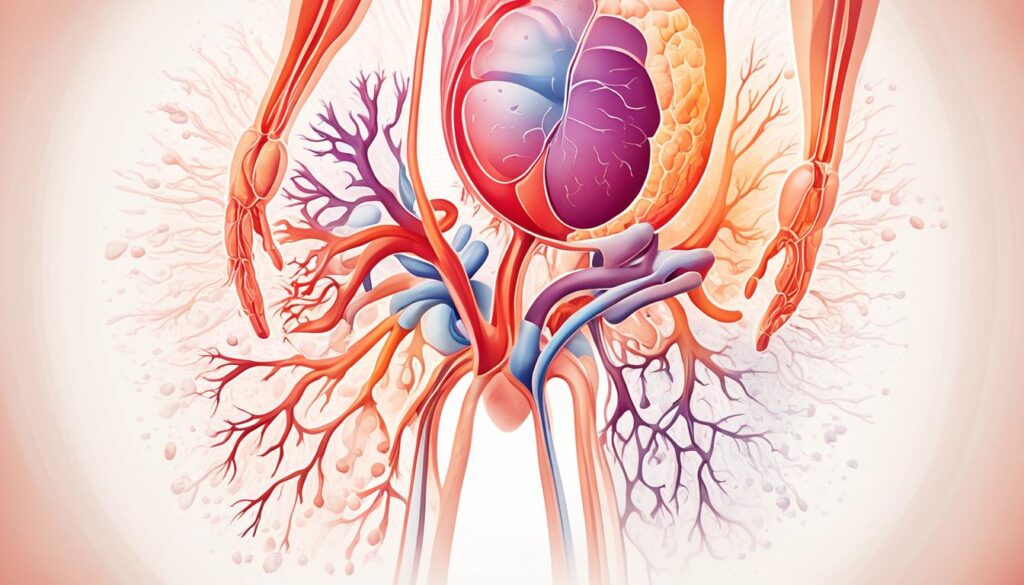
Visually, this image depicts a representation of the symptoms and signs of testicular cancer. The alt tag is testicular cancer symptoms, which corresponds to the SEO keyword for this section.
Please remember that self-diagnosis is not recommended, and only a medical professional can provide accurate diagnosis and treatment options based on your specific situation.
Prognosis and Follow-up for Testicular Cancer
The prognosis for testicular cancer is generally positive, with high cure rates, especially when detected and treated early. The specific prognosis depends on the type and stage of cancer, as well as your age and overall health. Studies have shown that testicular cancer has a 95% to 98% five-year survival rate if it is localized. The survival rate drops to approximately 73% if the cancer has spread to distant organs.
It’s important to note that each individual’s prognosis can vary based on several factors, including the specific characteristics of the cancer and the patient. Your healthcare team will provide a more accurate prognosis based on your unique situation.
After completing treatment for testicular cancer, follow-up tests and regular check-ups are recommended to monitor for any signs of recurrence. These follow-up appointments are crucial for tracking your progress and ensuring early detection of any potential issues. Some of the common follow-up tests may include:
- Physical examination: Your doctor will examine your testicles, abdomen, and lymph nodes to check for any abnormalities.
- Tumor marker tests: Blood tests such as alpha-fetoprotein (AFP), human chorionic gonadotropin (hCG), and lactate dehydrogenase (LDH) may be done to monitor the levels of these markers. Elevated levels may indicate the presence of cancer.
- Imaging tests: Scans, such as computed tomography (CT) scans or chest X-rays, may be performed to detect any signs of cancer recurrence or the spread of cancer cells to other areas of the body.
It’s essential to attend all follow-up appointments and communicate any new symptoms or concerns to your healthcare team. Remember that even if your testicular cancer was successfully treated, there is still a risk of recurrence. Regular screenings and medical care can help ensure that any potential issues are identified and addressed promptly.
By prioritizing your follow-up care and working closely with your healthcare team, you can take proactive steps towards your continued well-being and early detection of any potential testicular cancer recurrence.
Palliative Care for Testicular Cancer
In some cases of advanced or metastatic testicular cancer, palliative care may be recommended to help manage symptoms and improve the patient’s quality of life. Palliative treatment options may include radiation therapy, chemotherapy, or other drug therapies aimed at relieving pain and alleviating other symptoms.
Palliative care focuses on providing physical, emotional, and psychological support to individuals living with cancer and their families. It aims to enhance the overall well-being and quality of life by addressing pain, discomfort, and other symptoms associated with the disease.
“Palliative care offers a holistic approach to testicular cancer treatment by focusing not only on medical interventions but also on improving the patient’s emotional and psychological well-being,” says Dr. Ravi Singh, an oncologist specializing in men’s health.
Palliative care teams consist of healthcare professionals such as doctors, nurses, social workers, and counselors who work together to develop personalized care plans that address the individual needs and preferences of patients. They provide guidance on pain management, symptom control, and emotional support throughout the treatment process.
Through palliative care, patients and their families are empowered to make informed decisions about their treatment options. The goal is to achieve the highest possible level of comfort and quality of life, regardless of the stage or prognosis of the disease.
Dr. Singh emphasizes, “In addition to medical treatments, palliative care also involves providing emotional support to patients and their families, offering them the necessary resources and coping strategies to navigate the challenges and uncertainties that come with a testicular cancer diagnosis.”

Conclusion
Testicular cancer is a relatively rare but important issue that affects young men. Awareness and early detection play a crucial role in improving treatment outcomes and ensuring men’s health. By understanding the risk factors, symptoms, and treatment options, men can take proactive steps towards their well-being and prioritize their testicular health.
Regular self-checks and medical screenings are vital in the early detection of testicular cancer. This includes performing monthly self-examinations to check for any abnormal lumps or swelling in the testicles. Seeking timely medical attention and consulting a healthcare professional at the first sign of any concerning symptoms is essential for a prompt diagnosis and appropriate treatment.
By raising testicular cancer awareness, we can empower men to take control of their own health and encourage them to prioritize regular screenings. Early detection not only increases the chances of successful treatment but also promotes overall well-being. Together, let us spread awareness about testicular cancer and the importance of early detection for men’s health.
FAQ
What is testicular cancer?
Testicular cancer is a relatively rare form of cancer that primarily affects young men between the ages of 15 and 45. It starts in the testicles, which are responsible for producing sperm and the hormone testosterone.
What are the symptoms of testicular cancer?
The most common symptom of testicular cancer is a painless lump or swelling in the testicle. Other symptoms may include a feeling of heaviness in the scrotum, a dull ache in the lower belly or groin, sudden swelling in the scrotum, pain or discomfort in the testicle or scrotum, and enlargement or tenderness of the breast tissue.
How is testicular cancer diagnosed?
To diagnose testicular cancer, a doctor will perform a physical examination of the testicles and scrotum, looking for lumps or swelling. Additional tests such as ultrasound and blood tests may be conducted to confirm the presence of a mass and determine the tumor markers. The only way to definitively diagnose testicular cancer is through the surgical removal of the affected testicle.
What are the treatment options for testicular cancer?
The treatment for testicular cancer depends on the stage and type of cancer but may include surgery, radiation therapy, and chemotherapy. Surgery is the primary treatment and involves removing the affected testicle through an orchiectomy. In some cases, testis-sparing surgery may be an option, where only the tumor tissue is removed instead of the entire testicle. Radiation therapy is used to kill cancer cells in the testis or nearby lymph nodes, and chemotherapy is often used for cancers that have spread beyond the testicles or if tumor markers rise after surgery.
What is surveillance as a treatment option for testicular cancer?
Surveillance is a treatment option for certain stages of testicular cancer. It involves regular check-ups, including physical exams, tumor marker tests, and imaging tests. Surveillance is recommended for patients with stage 0 and some stage I cancers. It helps monitor for any signs of growth or changes in hormone levels that may require further treatment.
What are the risk factors for testicular cancer?
Several risk factors may increase the likelihood of developing testicular cancer. These include having an undescended testicle, a family history of testicular cancer, being a young adult, and being of white race. Other factors such as infertility, HIV and AIDS, physical features like Hypospadias, regular cannabis use, and certain intersex variations may also contribute to an increased risk.
Can testicular cancer be prevented?
Currently, there are no known ways to prevent testicular cancer. The focus is primarily on early detection and timely treatment through regular self-checks and medical screenings.
What is the prognosis for testicular cancer?
The prognosis for testicular cancer is generally positive, with high cure rates, especially when detected and treated early. The specific prognosis depends on the type and stage of cancer, as well as the individual’s age and overall health. Follow-up tests and regular check-ups are recommended after treatment to monitor for any signs of recurrence.
What is palliative care for testicular cancer?
In some cases of advanced or metastatic testicular cancer, palliative care may be recommended to help manage symptoms and improve the patient’s quality of life. Palliative treatment options may include radiation therapy, chemotherapy, or other drug therapies aimed at relieving pain and alleviating other symptoms.
Why is early detection of testicular cancer important?
Early detection of testicular cancer is crucial for successful treatment. Regular self-checks and medical screenings can help detect any abnormalities in the testicles and prompt timely medical attention, improving the chances of positive outcomes. Being aware of the risk factors, symptoms, and treatment options for testicular cancer is essential for promoting men’s health and raising awareness about this important issue.
